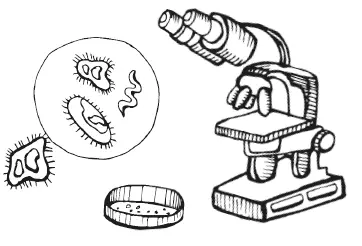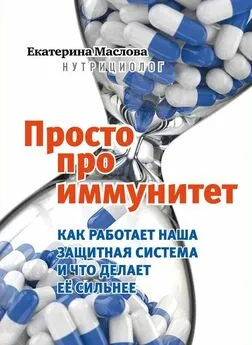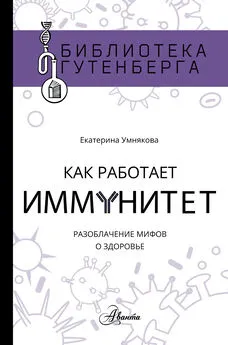Екатерина Умнякова - Как работает иммунитет [litres]
- Название:Как работает иммунитет [litres]
- Автор:
- Жанр:
- Издательство:Литагент АСТ
- Год:2019
- Город:М.
- ISBN:978-5-17-112323-9
- Рейтинг:
- Избранное:Добавить в избранное
-
Отзывы:
-
Ваша оценка:
Екатерина Умнякова - Как работает иммунитет [litres] краткое содержание
Для широкого круга читателей.
Как работает иммунитет [litres] - читать онлайн бесплатно ознакомительный отрывок
Интервал:
Закладка:
Cannon W.B. Bodily changes in pain, hunger, fear and rage. New York: Appleton and Co., 1915; Quick J.C., Spielberger C.D. Walter Bradford Cannon: pioneer of stress research, international journal of stress management. // International Journal of Stress Management. 1994. Volume 1, № 2. P. 141–143.
SelyeH. Stressanddisease. // TheLaryngoscope. 1955. Vol. 65, № 7. P. 500–514.
Selye, H. (1976). Stress in health and disease. Boston: Butterworths. – 1300 pp.
Cosentino M, Kustrimovic N & F Marino, Endogenous catecholamines in immune cells: Discovery, functions and clinical potential as therapeutic targets (October 5, 2013). In Brain Immune: Trends in Neuroendocrine Immunology. Retrieved April 27, 2017; Cosentino M, Marino F. Nerve-driven immunity: noradrenaline and adrenaline. In: Levite M. (ed.), Nerve-driven-immunity – Neurotransmitters and neuropeptides in the immune system. Springer-Verlag/Wien, 2012: pp. 47–96.
Coutinho A.E., Chapman K.E. The anti-inflammatory and immunosuppressive effects of glucocorticoids, recent developments and mechanistic insights. // Mol Cell Endocrinol. 2011. Vol. 335, № 31. P. 2–13.
Alhola P., Polo-Kantola P. Sleep deprivation: Impact on cognitive performance. // Neuropsychiatr Dis Treat. 2007. Vol. 3, № 5. P. 553–567.
Plog B.A., Nedergaard M. The glymphatic system in central nervous system health and disease: past, present, and future. // Annu Rev Pathol. 2018. Vol.13. P. 379–394.
Prather A.A.; Leung C.W. Association of insufficient sleep with respiratory infection among adults in the United States. // JAMA Intern Med. 2016. Vol. 176, № 6. P. 850–852.
Chandra R.K. Nutrition and the immune system: an introduction. // Am J Clin Nutr. 1997. Vol. 66, № 2. P. 460S-463S.
Bourke C.D., Berkley J.A., Prendergast A.J. Immune dysfunction as a cause and consequence of malnutrition. // Trends Immunol. 2016. Vol. 37, № 6. P. 386–398.
Calder P.C., Jackson A.A. Undernutrition, infection and immune function. // Nutr Res Rev. 2000. Vol. 13, № 1. P. 3–29; Chandra R.K. 1990 McCollum Award lecture. Nutrition and immunity: lessons from the past and new insights into the future. // Am J Clin Nutr. 1991 Vol. 53, № 5. P. 1087–1101.
PrasadA.S. Zincandimmunity.// Mol Cell Biochem. 1998. Vol. 188, № 1–2, P. 63–69.
Hoffmann P.R., Berry M.J. The influence of selenium on immune responses. // Mol Nutr Food Res. 2008. Vol. 52, № 11. P. 1273–1280.
de Heredia F.P., Gómez-Martínez S., Marcos A. Obesity, inflammation and the immune system. // Proc Nutr Soc. 2012. Vol. 71, № 2. P. 332–338).
(Han S.N., Jeon K.J., Kim M.S., Kim H.K., Lee A.J. Obesity with a body mass index under 30 does not significantly impair the immune response in young adults. // Nutr Res. 2011. Vol. 31, № 5. P. 362–369.
Кортикостероном и другими. Они действуют угнетающе на работу иммунных клеток и образование провоспалительных сигнальных молекул. (Cosentino M, Kustrimovic N & F Marino, Endogenous catecholamines in immune cells: Discovery, functions and clinical potential as therapeutic targets (October 5, 2013). In BrainImmune: Trends in Neuroendocrine Immunology. Retrieved April 27, 2017; Cosentino M, Marino F. Nerve-driven immunity: noradrenaline and adrenaline. In: Levite M. (ed.), Nerve-driven-immunity – Neurotransmitters and neuropeptides in the immune system. Springer-Verlag/Wien, 2012: pp. 47–96; Coutinho A.E., Chapman K.E. The anti-inflammatory and immunosuppressive effects of glucocorticoids, recent developments and mechanistic insights. // Mol Cell Endocrinol. 2011. Vol. 335, № 31. P. 2–13.
LaVoy E.C., McFarlin B.K., Simpson R.J.Immune responses to exercising in a cold environment. // Wilderness Environ Med. 2011. Vol. 22, № 4. P. 343–351.
Hu G.-Z., Yang S.-J., Hu W.-X., Wen Z., He D., Zeng L.-F., Xiang Q., Wu X.-M. Zhou W.-Y., Zhu Q.-X. Effect of cold stress on immunity in rats. // Exp Ther Med. 2016. Vol. 11, № 1. P. 33–42.
Чурилов Л.П., Васильев А.Г., Утехин В.И. Краткая история иммунологии глазами патофизиологов. // Здоровье – основа человеческого потенциала. Проблемы и пути их решения. 2017. Том 12, № 2. C. 224–275.
Ульянкина Т.И. Зарождение иммунологии. М.: Наука, 1994 – 319 с.).
Поль де Крюи Охотники за микробами. СПб.: Амфора, 2015, – 352 с., Ульянкина Т.И. Зарождение иммунологии. М.: Наука, 1994 – 319 с.
Pitt D., Aubin J-M. Joseph Lister: father of modern surgery. // Can J Surg. 2012. Vol. 55, № 5. P. E8–E9).
Поль де Крюи Охотники за микробами. СПб.: Амфора, 2015, – 352 с.
Мечников И. И. О целебных силах организма. Протоколы VII съезда естествоиспытателей и врачей. Приложение 1. Одесса; 1883. С. 21–22.
Metchnikoff E. La lutte pour l’existence entre les diverses parties de l’organisme. Rev. Sci. 1892. Vol. 11. P. 324.
Чурилов Л.П., Васильев А.Г., Утехин В.И. Краткая история иммунологии глазами патофизиологов. // Здоровье – основа человеческого потенциала. Проблемы и пути их решения. 2017. Том 12, № 2. C. 824–275; Ульянкина Т.И. Зарождение иммунологии. М.: Наука, 1994 – 319 с.
Джессика Снейдер Сакс. «Микробы хорошие и плохие» М.: АСТ: CORPUS, 2014. – 496 c., Ульянкина Т.И. Зарождение иммунологии. М.: Наука, 1994 – 319 с.
Weisse A.B. Self-experimentation and its role in medical research. // Tex. Heart. Inst. J. 2012. Vol. 39, № 1. P. 51–54.
Marshall B., Adams P.C. Helicobacter pylori: A Nobel pursuit? CanJGastroenterol. 2008. Vol. 22, № 11. P. 895–896.
Ульянкина Т.И. Зарождение иммунологии. М.: Наука, 1994 – 319 с.
Adli M. The CRISPR tool kit for genome editing and beyond. // Nature Communications. 2018. Vol. 9, Articlenumber: 1911.
Yin C., Zhang T., Qu X., Zhang Y., Putatunda R., Xiao X., Li F., Xiao W., Zhao H., Dai S., Qin X., Mo X., Young W.-B., Khalili K., Hu W. In vivo excision of HIV-1 provirus by saCas9 and multiplex single-guide RNAs in animal models. // Molecular Therapy. 2017. Vol. 25, № 5. P. 1168–1186.
Moye Z.D., Woolston J., Sulakvelidze A. Bacteriophage applications for food production and processing. // Viruses. 2018. Vol. 10, № 4. Article 205.
Gharsallaoui A., Oulahal N., Joly C., Degraeve P. Nisin as a food preservative: part 1: physicochemical properties, antimicrobial activity, and main uses. // Crit Rev Food Sci Nutr. 2016. Vol. 56, № 8. P. 1262–1274.
Shin J.M., Gwak J.W., Kamarajan P., Fenno J.C., Rickard A.H., Kapila Y.L. Biomedical Applications of nisin. // J Appl Microbiol. 2016. Vol. 120, № 6. P. 1449–1465.
Larsen A.G., Knøchel S. Antimicrobial activity of food-related Penicillium sp. Against pathogenic bacteria in laboratory media and a cheese model system. // Journal of Applied Microbiology 1997, 83, 111–119.
Uehling J., Deveau A., Paoletti M. Do fungi have an innate immune response? An NLR-based comparison to plant and animal immune systems. // PLOS ONE. Pathogens. 2017. Vol. 13, № 10. Article: e1006578.
Zhai Y., Saier M.H. The amoebapore superfamily. // Biochim Biophys Acta. 2000. Vol. 1469, № 2. P. 87–99.
KrenskyA.M., ClaybergerC. Granulysin: anovelhostdefensemolecule. // AmJTransplant. 2005. Vol. 5, № 8. P.1789–1792.
Егоров Ц.А., Одинцова Т.И. Защитные пептиды иммунитета растений. // Биоорганическая химия. 2012. Том 38, № 1. С. 7–17.
Katiyar-Agarwal S., Morgan R., Dahlbeck D., Borsani O., Villegas A. Jr., Zhu J.K., Staskawicz B.J., Jin H. A pathogen-inducible endogenous siRNA in plant immunity. // Proc Natl Acad Sci USA. 2006. Vol. 21, № 103(47). P. 18002–18007.
Loker E.S., Adema C.M., Zhang S.-M., Kepler T.B. Invertebrate immune systems – not homogeneous, not simple, not well understood. // Immunol Rev. 2004. Vol. 198. P. 10–24.

Примечания
1
В последнем пункте эти условия определяются строго индивидуально, каждый человек самостоятельно узнает, какие факторы действуют на него благоприятно, а какие становятся стрессом и приносят дискомфорт.
Интервал:
Закладка:
![Обложка книги Екатерина Умнякова - Как работает иммунитет [litres]](/books/1082598/ekaterina-umnyakova-kak-rabotaet-immunitet-litres.webp)
![Екатерина Мекачима - За тридевять земель [litres]](/books/1056641/ekaterina-mekachima-za-tridevyat-zemel-litres.webp)
![Екатерина Васина - Да, детка, это – реальность! [litres]](/books/1057960/ekaterina-vasina-da-detka-eto-realnost-lit.webp)
![Екатерина Урузбиева - Охота на Тени [litres]](/books/1062038/ekaterina-uruzbieva-ohota-na-teni-litres.webp)
![Екатерина Флат - В погоне за тайной [litres]](/books/1063073/ekaterina-flat-v-pogone-za-tajnoj-litres.webp)
![Екатерина Рождественская - Балкон на Кутузовском [litres]](/books/1064280/ekaterina-rozhdestvenskaya-balkon-na-kutuzovskom-li.webp)
![Екатерина Звонцова - Серебряная клятва [litres]](/books/1064926/ekaterina-zvoncova-serebryanaya-klyatva-litres.webp)
![Екатерина Елизарова - Хранительница дракона [litres]](/books/1066933/ekaterina-elizarova-hranitelnica-drakona-litres.webp)
![Екатерина Соболь - Призрачный сыщик [litres]](/books/1143957/ekaterina-sobol-prizrachnyj-sychik-litres.webp)

